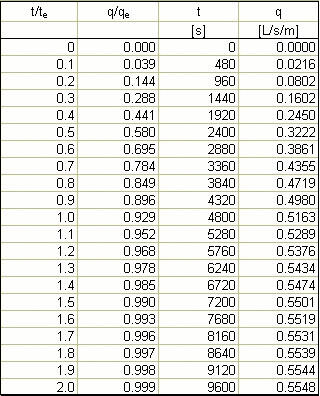CIV E 445 - APPLIED HYDROLOGY
SPRING 2014
HOMEWORK No. 5 SOLUTION
Since rainfall duration is greater than time of concentration, the flow is superconcentrated and the entire catchment is contributing. For subcatchments with different runoff coefficients, use a weighted formula for peak runoff (see Eq. 4-14):
Qp = I Σ(CA)
Qp = 55 mm/h × [ (0.3 × 175 × 30/100) + (0.5 × 175 × 40/100) + (0.9 × 175 × 30/100) ] ha × (10,000 m2/ha × 0.001 m/mm) / (3600 s/h) =
Qp = 14.97 m3/s. ANSWER.
Several rainfall durations are tried, as shown in the following table.
| tr (min) | I (mm/h) | Subarea A (C = 0.9) (ha) | Subarea B (C = 0.3) (ha) | Σ(CA) | Qp (m3/s) |
| 20 | 147.7 | 66 | 51.33 | 74.8 | 30.68 |
| 30 | 123.9 | 66 | 77 | 82.5 | 28.4 |
| 40 | 107.5 | 66 | 102.67 | 90.2 | 26.95 |
| 50 | 95.5 | 66 | 128.33 | 97.9 | 25.96 |
| 60 | 86.1 | 66 | 154 | 105.6 | 25.26 |
The fraction of subarea B contributing to peak runoff increases linearly with rainfall duration.
Therefore: Qp = I Σ(CA), in m3/s.
The 50-y peak runoff is the maximum value, corresponding to a 60-min duration:
Using Eq. 4-19, the equilibrium outflow is:
qe = iL / 3600 = (40 mm/h × 100 m × 0.001 m/mm × 1000 Liters/m3) / (3600 s/h) =
qe = 1.11 Liters/s/m = 1.11 × 10-3 m3/s/m = 0.00111 m2/s.
For T = 20°C, ν = 1.0 × 10-6 m2/s (Table A-1).
Using Eq. 4-27: CL = (9.81 m/s2 × 0.015) / (3 × 1.0 × 10-6 m2/s) = 49,050 m-1s-1.
In Eq. 4-25, for laminar flow, b = CL, and m = 3.
Therefore:
For T = 30°C, ν = 0.801 × 10-6 m2/s.
Using Eq. 4-27: CL = 61,236 m-1s-1.
Therefore:
The rainfall excess in m/s is:
i = (25 mm/h × 0.001 m/mm) / (3600 s/h) = 6.94×10-6 m/s.
qe = 6.94×10-6 m/s × 80 m = 0.0005555 m3/s/m = 0.5555 L/s/m.
For 75% turbulent flow, m = 2. Therefore, in Eq. 4-29:
te = [ 2 × (0.05 × 80)1 / 2 ] / [(6.94×10-6)1 / 2 × 0.011 / 4] = 4800 s.
Using Eq. 4-36, the rising limb of the overland flow hydrograph is calculated as shown in the following table. ANSWER.
 |
 |